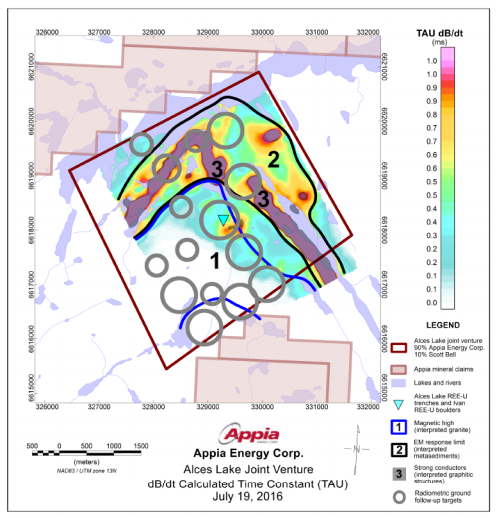The surveys were carried out over the property where earlier surface exploration programs conducted by Appia and others identified radioactive minerals uranium and thorium in the Alces Lake trenches and the recently discovered Ivan Zone (previously reported in the Company’s news release dated May 22, 2014) as well as rare earth element (“REE”) mineralization ranging from 1.1% to 35.7% by weight. The REE outcrops and boulder trains exhibit uranium plus thorium radioactivity levels in excess of 56,000 cps measured with an RS-230 hand-held spectrometer.
The survey results have provided input for geological interpretations of the Alces Lake property. The magnetic survey successfully delineated a large area registering as a magnetic high (unit 1 in figure 1). The Alces Lake trenches and Ivan Zone outcrop are located within this magnetic high zone.
A positive correlation exists between the interpreted magnetic data and numerous radiometric anomalies produced by eTh and eU, suggesting that the uranium and REE mineralization host-rock is widespread beneath the overburden cover.
The conductivity data (figure 2) has outlined weakly conductive limits (unit 2) that have been interpreted to represent the extent of metasedimentary gneiss, as well as two highly conductive corridors (unit 3) that have been interpreted as graphitic structures, similar to those that host numerous Athabasca high-grade uranium deposits.
The eU and eTh radioactivity results (figures 3 and 4) were used in combination to identify a number of immediate follow-up anomalies across the property with radioactive signatures similar to those observed at the Alces Lake and Ivan Zone outcrops. These survey results will play a key role in prioritizing future surface mapping and sampling programs over the newly identified radiometric anomalies.
Appia’s Director of Saskatchewan Operations, James Sykes, comments; “We are very excited about the high-calibre results of the Geotech survey. The information gained from the survey will play a key role in identifying new surface showings as well as defining the sub-surface extent of the uranium and REE mineralization observed at surface”.
The 147 line-kilometre helicopter-borne survey over the Alces Lake joint venture property included a versatile time-domain electromagnetic system (VTEM™ Plus), horizontal magnetic gradiometer with two caesium magnetometers and RSI ARGS RSX-5 gamma ray spectrometer.
Appia holds 90% interest in the Alces Lake joint venture and is the operator.
About Appia
Appia is a Canadian publicly-traded company in the uranium and rare earth sectors. The company has NI 43-101 compliant resources of 8.0 M lbs U3O8 and 70.8 M lbs REO Indicated, and 47.7 M lbs U3O8 and 197.6 M lbs REO Inferred in the Elliot Lake, ON, historic mining camp. The resources are largely unconstrained along strike and down dip.
The company also maintains a focus for discovering high-grade uranium in the prolific Athabasca Basin on its two flagship properties, Otherside and Loranger, and discovering and delineating high-grade REO’s and uranium on its Alces Lake joint venture. The company holds the surface rights to exploration for about 84,000 hectares in Saskatchewan. Read the press release here.
Timeline
Appia Appoints Geotech Ltd. to Fly a VTEM plus survey 31 May 2016

dB/dt Calculated Time Constant
signatures (black outline, unit 2) defined
by the survey are interpreted to represent
metasedimentary gneiss, with high TAU
signatures (grey polygons, unit 3) interpreted
as graphitic structures, similar to those hosting
high-grade uranium deposits in the Athabasca
Basin.
The accompanying figures can be found here.